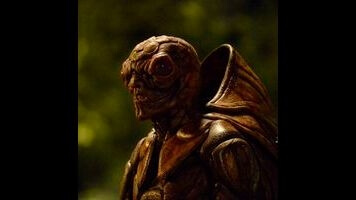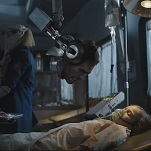When it comes to tone, Grimm usually manages to keep things on the serious side. The wesen that Team Grimm goes up against on a weekly basis lean toward either tragic or villainous, not straying far from the darkness inherent in their source material. Larger organizations like the royal families, the Wesenrein, or Black Claw, are indisputably evil and lacking in moral ambiguity. Lighter moments are certainly present—a bit of Wu gallows humor, Monroe getting excited about historical minutiae, Bud having his umpteenth nervous breakdown—but they exist largely to break the tension rather than taking over.
And then an episode like “The Seven Year Itch” decides to end a dramatic fight scene with a hippopotamus wesen biting the head off a cicada wesen. It’s one of the goofiest and most anticlimactic moments I’ve ever seen on the series, one that definitely works in the moment for absurdity and shock value but one that doesn’t make for a satisfying close to the story. If nothing else though, it at least fits into the whole of “The Seven Year Itch,” an episode that has some intermittently interesting moments but for the most part misses the mark on what it’s trying to achieve.
Some of the problems for that lie with the wesen in question, a cicada-inspired creature who turns out to be one of Portland’s first settlers. There’s something inherently interesting in the concept of a long-lived wesen who only gets a handful of days and doesn’t view life the same way as a result. That isn’t what we get here, as the interactions with Stillman are largely superficial ones that make him come across as a dick who just happens to eat people. He gorges himself at meals, talks about loving life, stabs people, and digs a hole in the ground—not exactly a complex antagonist.
The design of the wesen also doesn’t help matters. Coming on the heels of “El Cuegle” it’s clear the creative team is going for broke in the final season, and in their minds the weirder the wesen the better. Unfortunately, that desire is further removing the wesen from respectability, as Stillman’s woge looks closer to something out of Starship Troopers than anything we’ve seen before. They also go to the trouble to establish him as a wesen with wings and there’s not a single flight scene, which budget considerations aside feels like a wasted opportunity.
As far as the procedural element goes, it’s not the strongest investigation the team’s ever undergone. The majority of the action is contained in long expositional scenes, be it Hank and Nick walking through the exact series of events that went into the murder scene, or the medical examiner blithely going through a list of injuries to the first corpse that any normal medical examiner would be losing her mind over. Monroe’s confusion over the police sketch and gradual identification is a highlight, but that’s more attributable to Silas Weir Mitchell’s facial expression than any basic plotting. There’s no real action, just a series of exposition and random events to move from one point to the next.
The rest of the episode is a mixed bag, and also calls to attention a problem with the timeline of this last season of Grimm. Renard has somehow moved overnight from the Black Claw mansion to a ridiculously posh house overlooking the city, which a police captain’s salary—or even a mayor’s salary—wouldn’t come close to covering and which is already completely furnished. It’s unclear how long Rosalee’s been pregnant, and an open question if the show will even bother with padding her given there’s less than ten episodes remaining. Julievette has been living in the tunnels for an undisclosed period of time and everyone acts shocked to hear it, despite the fact that no one has looked up to ask where their friend and colleague is. There’s no sense of how much time has passed or what major events have take place in the interim, it’s just skipping ahead in the places it finds that necessary.
Regarding the latter, Julievette does get out of the tunnels thanks to Diana’s psychic abilities, which puts her in proximity to Adalind for the first time in a long while. “The Seven Year Itch” is at least aware that the history between Adalind and Julievette is a complex one, and it makes an effort to touch on that with Adalind apologizing for her previous actions. However, the amount of time since these characters have interacted—and the fact that one of them technically died in the interim—robs it of any feeling of resolution. Adding Nick to the mix doesn’t add much of a spark either, more a sense of testing a love triangle that’s dead on arrival.
Also in danger of a narrative quagmire is Renard, as having seemingly abandoned the Big Bad route he doesn’t have a plot to speak of. He’s not involved at all with the case of the week and tensions with Adalind have seemingly evaporated into a cordial divorced parent relationship, so the only thing he has to do is bicker with the ghost of Meisner. Again, the tone is all over the place in these interactions, Renard’s increasing desperation and visions of corpses countered by Meisner’s seemingly bored attitude and Damien Puckler’s truly ridiculous accent work.
Yet ridiculous accents have nothing on the second half of his story, wherein Renard is subjected to a literal ghostbusting. Out of nowhere there’s a pawn shop whose owner Renard has history with, he trades said pawnbroker a family heirloom and his fake marriage wedding ring—the latter of which he’s inexplicably reluctant to part with—and he’s plugged into a steampunk-style machine that just happened to be behind a curtain. (And he needs to have his shirt off for it, because of course he does.) All of this has the stink of retreading the Jack the Ripper arc from season four, Renard off on a hallucinatory adventure that’s only tangentially related to everything else the rest of the cast is up to. It doesn’t even have the feeling of a redemption arc for the character, just batting him around for the foreseeable future.
There are a few things to redeem “The Seven Year Itch”—Diana’s continued straddling of the childlike and the omnipotent, Monroe’s detective work, and the blacklight-inspired scene of the chalk drawings in the tunnel. However, on the whole it’s a largely muddled episode of Grimm, one that inches its plots forward but doesn’t do anything revelatory or inspired with any of them, the sort of storytelling I’d hoped the show had grown out of in season five. Let’s just hang onto the moment of the hippo decapitating the cicada with his mouth and hope things get more focused next week.
Stray observations:
- This Week In Portland: Nick and Hank grab their morning coffee at Fuller’s, and Stillman grabs his victim from The Whiskey Bar. There is no Stillman Park in the city, which is somewhat surprising given how many parks there are in Portland city limits.
- This Week’s Epigram: Grimm’s writers get a title and an epigram from one place, borrowing both from the 1955 Billy Wilder film. They should be congratulated for avoiding the temptation to pay homage to Marilyn Monroe’s famous subway grate scene.
- Congratulations to Kyle Nabilcy of Isthmus, who proposed on Twitter the best name for the cloth of mysterious symbols. Going forward, it shall be referred to as “The Shroud of Curin’.”
- Even with all the fantastical stuff, the thing that bothered me the most is that Stillman was able to woge and keep his suit intact. That just doesn’t feel right.
- Note that the hippo wesen recognizes Nick as a Grimm and doesn’t seem bothered by it at all. Always nice to see a reminder that Portland’s general wesen population is fully aware of Nick and that he’s on their side.
- Monrosalee are having a litter! It’s triplets.
- “A catcher’s mitt, which I suppose could have covered his essentials.”
- “I’m not sure I can commit to the half-assed haunting. I think we have some real issues to work through.”








































